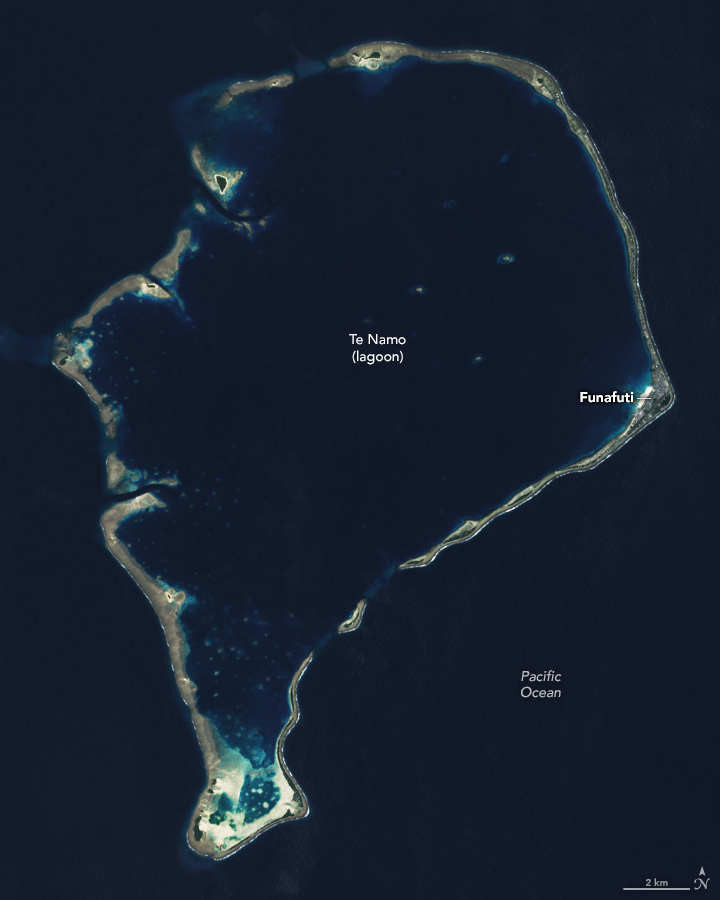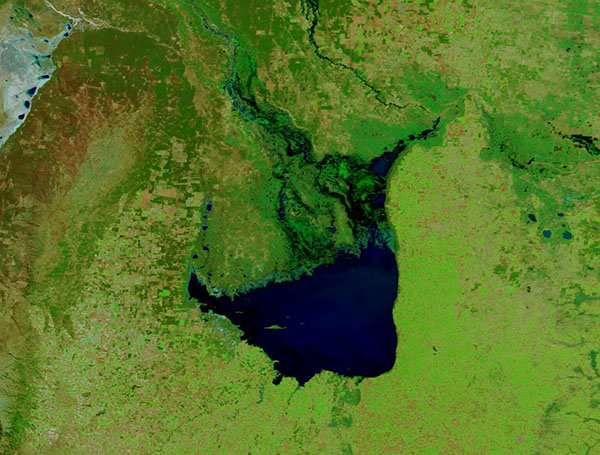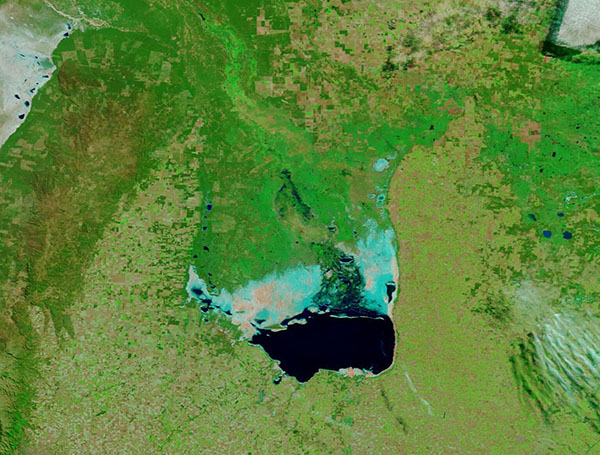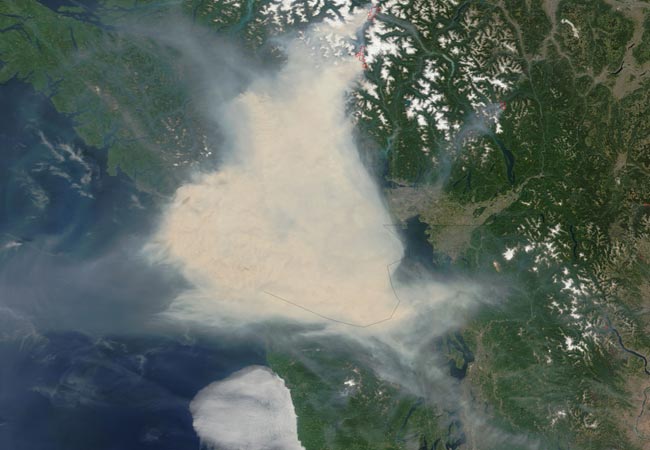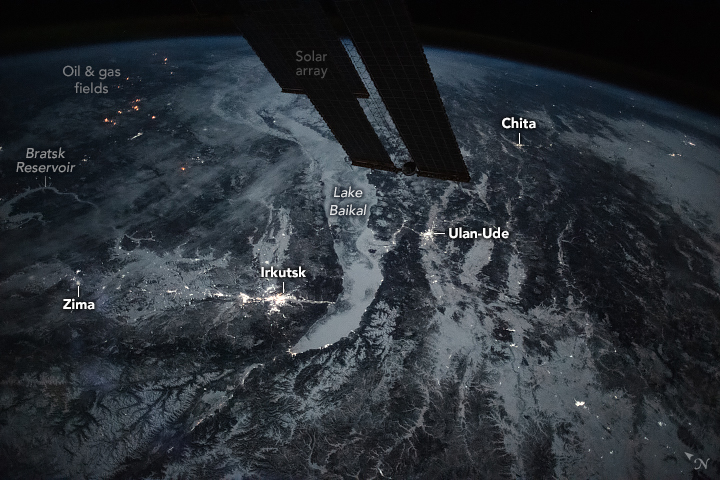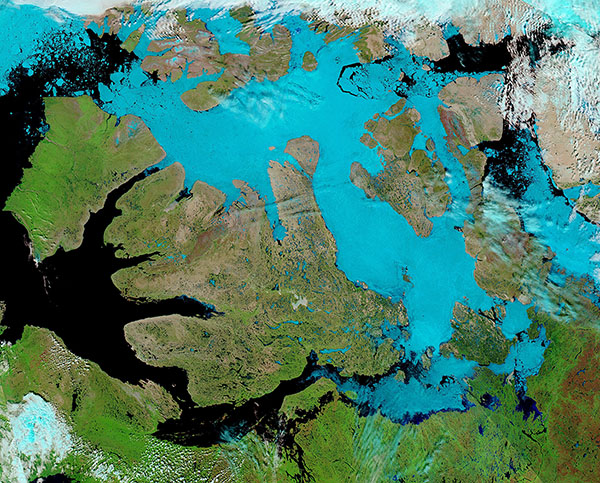Weather history miscellany
Re: Weather history miscellany
https://www.weatherforyou.com/weather_history/7-21
1934 - The temperature reached 109 degrees at Cincinnati, OH, to cap their hottest summer of record. The state record for Ohio was established that day with a reading of 113 degrees near the town of Gallipolis. (David Ludlum)
1988 - While cool air invaded the central U.S., unseasonably hot weather continued over the western states. The temperature at Spring Valley, NV, soared from a morning low of 35 degrees to an afternoon high of 95 degrees. Fallon, NV, reported an all-time record high of 108 degrees, and Death Valley, CA, reported their sixth straight day of 120 degree heat. (The Weather Channel) (The National Weather Summary)
1934 - The temperature reached 109 degrees at Cincinnati, OH, to cap their hottest summer of record. The state record for Ohio was established that day with a reading of 113 degrees near the town of Gallipolis. (David Ludlum)
1988 - While cool air invaded the central U.S., unseasonably hot weather continued over the western states. The temperature at Spring Valley, NV, soared from a morning low of 35 degrees to an afternoon high of 95 degrees. Fallon, NV, reported an all-time record high of 108 degrees, and Death Valley, CA, reported their sixth straight day of 120 degree heat. (The Weather Channel) (The National Weather Summary)
Re: Weather history miscellany
https://www.weatherforyou.com/weather_history/7-22
1918 - A single bolt of lightning struck 504 sheep dead in their tracks at the Wasatch National Forest in Utah. Sheep often herd together in storms, and as a result the shock from the lightning bolt was passed from one animal to another. (David Ludlum)
1986 - Hurricane Estelle passed 120 miles south of the Hawaiian Islands creating a ten to twenty foot surf. The large swells resulted from a combination of high tides, a full moon, and 50 mph winds. The hurricane also deluged Oahu Island with as much as 6.86 inches of rain on the 24th and 25th of the month. (Storm Data)
1988 - Six cities in the south central U.S. reported record low temperatures for the date, including Pueblo, CO, with a reading of 48 degrees. Thunderstorms over the Atlantic Coast Region drenched Wilmington, NC, with 6.49 inches of rain in about eight hours. (The National Weather Summary)
1918 - A single bolt of lightning struck 504 sheep dead in their tracks at the Wasatch National Forest in Utah. Sheep often herd together in storms, and as a result the shock from the lightning bolt was passed from one animal to another. (David Ludlum)
1986 - Hurricane Estelle passed 120 miles south of the Hawaiian Islands creating a ten to twenty foot surf. The large swells resulted from a combination of high tides, a full moon, and 50 mph winds. The hurricane also deluged Oahu Island with as much as 6.86 inches of rain on the 24th and 25th of the month. (Storm Data)
1988 - Six cities in the south central U.S. reported record low temperatures for the date, including Pueblo, CO, with a reading of 48 degrees. Thunderstorms over the Atlantic Coast Region drenched Wilmington, NC, with 6.49 inches of rain in about eight hours. (The National Weather Summary)
Re: Weather history miscellany
NASA Earth Observatory - 2016
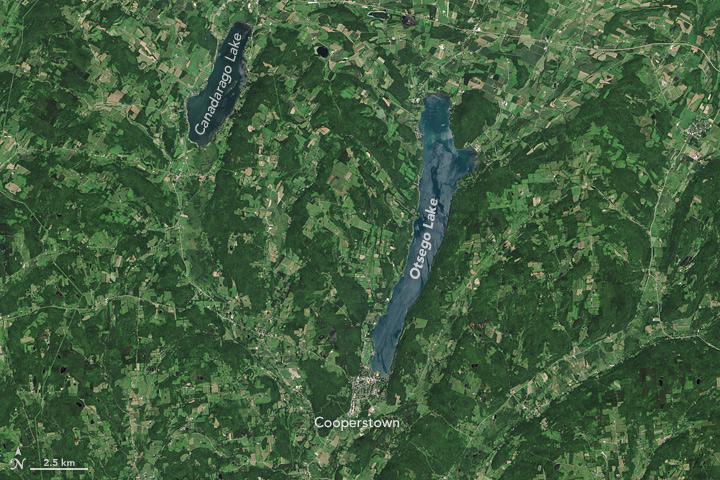
(July 16, 2015)
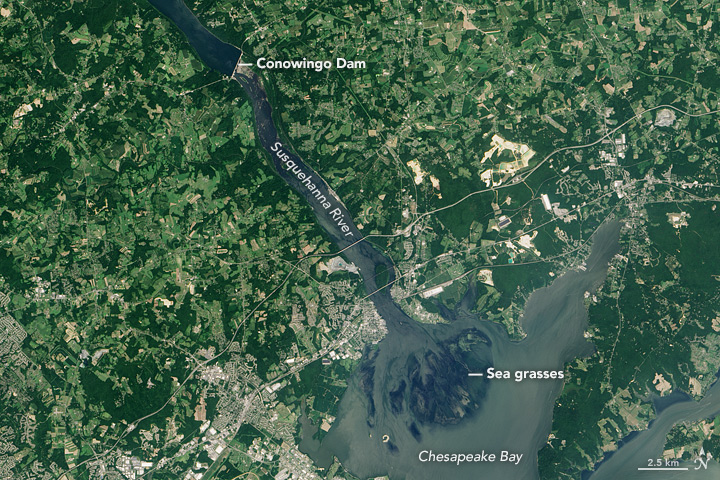
(August 17, 2015)
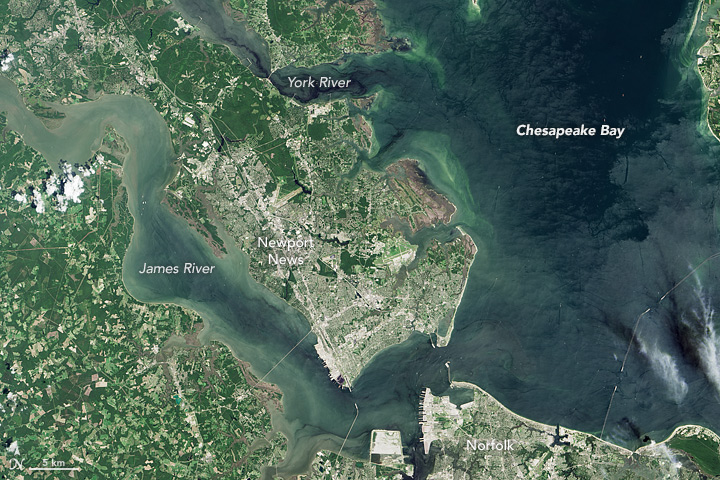
(July 25, 2015)
Following a Raindrop from New York to Newport News
https://www.geonames.org/4352155/conowingo-dam.html

(July 16, 2015)

(August 17, 2015)

(July 25, 2015)
Following a Raindrop from New York to Newport News
https://www.geonames.org/4352155/conowingo-dam.html
Re: Weather history miscellany
https://www.weather.gov/abr/This_Day_in ... ory_Jul_23
1788: Called the George Washington's Hurricane, this storm originated near Bermuda on the 19th before making landfall in Virginia. It passed directly over the Lower Chesapeake Bay and Mount Vernon, the home of George Washington. This track is very similar to the path of the Chesapeake-Potomac hurricane of 1933. At Norfolk, winds increased at 5 p.m. on the 23rd with the wind originating from the northeast. At 12:30 a.m., the wind suddenly shifted to the south and "blew a perfect hurricane, tearing down chimneys, fences"...some corn was also leveled. Also, large trees were uprooted, and houses were moved from their foundations.
Port Royal and Hobb's Hole experienced a violent northeast gale which drove several vessels ashore. In Fredricksburg, vast quantities of corn, tobacco, and fruit were destroyed. Houses and trees fell in significant numbers across Northumberland, Lancaster, Richmond, and Westmoreland counties. Crops were destroyed, and many livestock perished in Lower Mathews County. Many plantations saw their houses leveled. Homes were flooded with water six feet deep, and several inhabitants drowned.
Historical figures of the time logged the storm's antics. George Washington noted the sinking of the small ship Federalist and uprooted trees. Colonel James Madison, the father of the future president, experienced the passing of great winds and rains near Orange. In Alexandria, damage to wheat, tobacco, and corn was "beyond description." The information above is from the Weather Prediction Center and noted American historian David Ludlum.
1788: Called the George Washington's Hurricane, this storm originated near Bermuda on the 19th before making landfall in Virginia. It passed directly over the Lower Chesapeake Bay and Mount Vernon, the home of George Washington. This track is very similar to the path of the Chesapeake-Potomac hurricane of 1933. At Norfolk, winds increased at 5 p.m. on the 23rd with the wind originating from the northeast. At 12:30 a.m., the wind suddenly shifted to the south and "blew a perfect hurricane, tearing down chimneys, fences"...some corn was also leveled. Also, large trees were uprooted, and houses were moved from their foundations.
Port Royal and Hobb's Hole experienced a violent northeast gale which drove several vessels ashore. In Fredricksburg, vast quantities of corn, tobacco, and fruit were destroyed. Houses and trees fell in significant numbers across Northumberland, Lancaster, Richmond, and Westmoreland counties. Crops were destroyed, and many livestock perished in Lower Mathews County. Many plantations saw their houses leveled. Homes were flooded with water six feet deep, and several inhabitants drowned.
Historical figures of the time logged the storm's antics. George Washington noted the sinking of the small ship Federalist and uprooted trees. Colonel James Madison, the father of the future president, experienced the passing of great winds and rains near Orange. In Alexandria, damage to wheat, tobacco, and corn was "beyond description." The information above is from the Weather Prediction Center and noted American historian David Ludlum.
Re: Weather history miscellany
https://www.weather.gov/abr/This_Day_in ... ory_Jul_24
1930: An estimated, F5 tornado tore through Montello, Veneto, and Friuli in Italy. The tornado killed 23 people along its 50 miles path. Click HERE for more information from 3Bmeteo.com.
1952: The temperature at Louisville, Georgia soared to 112 degrees to establish a state record. The temperature also hit 112 degrees in Greenville, Georgia on August 20, 1983.
1930: An estimated, F5 tornado tore through Montello, Veneto, and Friuli in Italy. The tornado killed 23 people along its 50 miles path. Click HERE for more information from 3Bmeteo.com.
1952: The temperature at Louisville, Georgia soared to 112 degrees to establish a state record. The temperature also hit 112 degrees in Greenville, Georgia on August 20, 1983.
Re: Weather history miscellany
https://www.weather.gov/abr/This_Day_in ... ory_Jul_25
1936: Lincoln, Nebraska saw an all-time high temperature of 115 degrees. The low only dropped to 91 degrees and the average temperature was 103. Many people spent the night sleeping outside to escape the heat.
Nebraska: Making Rain

During the 1890s some theorized that smoke particles blown into the clouds would precipitate rain.
These men appear to be trying that process. RG2545-9
1936: Lincoln, Nebraska saw an all-time high temperature of 115 degrees. The low only dropped to 91 degrees and the average temperature was 103. Many people spent the night sleeping outside to escape the heat.
Nebraska: Making Rain

During the 1890s some theorized that smoke particles blown into the clouds would precipitate rain.
These men appear to be trying that process. RG2545-9
Re: Weather history miscellany
https://www.weather.gov/abr/This_Day_in ... ory_Jul_26
1874: Torrential rainfall brought flash flooding to Pittsburgh, Pennsylvania.
1890: During the morning hours, an estimated F3 tornado went through the southern part of Lawrence, Massachusetts. The tornado left 500 people homeless as the tornado destroyed 35 homes and damaged 60 others. Click HERE for more information from ForgottenNewEngland.com.
1874: Torrential rainfall brought flash flooding to Pittsburgh, Pennsylvania.
Pittsburgh Post-Gazette wrote:Butcher’s Run Flood devastates O’Hara Street in 1874
July 26, 1874: A few days ago we visited the short section of Spring Garden Avenue that runs just west of Chestnut Street on the North Side. It’s a narrow residential street lined with those two- and three-story red brick houses you often see in older sections of the city. On this morning the neighborhood was quiet, except for the rumble of cars traveling along nearby Chestnut Street, which remains cobblestone.
It’s difficult to imagine that this street was once the scene of such horror that it became the center of national attention. Reporters from newspapers in the east stood here to learn about a tragedy. Artists sketched the scene for illustrated magazines, and at least one photographer was at work.
The year was 1874. This portion of Spring Garden Avenue was known as O’Hara Street, and it was at the center of a densely packed portion of Allegheny City. The event that lured newsmen to the street began around 8 o’clock on Sunday evening, July 26. Heavy raindrops splattered on wood plank roads as families settled down in their homes for the evening. Then the rain grew heavy, alarmingly so. Soon it was a torrent unlike any in recent memory. A thick darkness fell over the city. Newspapers called it “impenetrable,” except by frequent blasts of lightning.
Streams that flowed down from the hills above O’Hara Street began to fill with water. On a hillside near one of those streams lived a man named G.W. Day. As he peered out a window, a lightning flash revealed in an instant something terrifying: A wall of water was bearing down on his house. Day had no time to react. Fortunately, the flood had yet to gather deadly force.
Fed by water rushing down hillsides, the flood grew in strength and volume. Outbuildings and fences were swept away, trees uprooted and road planks tossed into the air by the fast-moving water.
Those in the flood’s path had little warning. Homes were inundated, pushed from foundations, overturned or, in some cases, completely torn part. Survivors groped for safety in the darkness.
John Shearing and his wife carried their sleeping 4-year-old sons out of the family’s house and onto a bank above the rushing waters. The storm aroused one of the boys. He awoke and rolled over the bank and into the raging flood. His body was recovered the next day.
The Leopold family’s three-story frame house was destroyed. Mrs. Leopold and her four children drowned. In addition, the flood killed five children from another family living on the third floor. The home of a cooper named Simon Dreyer was lifted up and set on its side. The family inside escaped serious injury.
John Fisher, a butcher, ran to a stable to save his horse. As the water rose, he sought safety in a hay-loft. Reaching down, he grabbed his horse’s bridle and held the animal’s head above the water, thus saving its life. Elsewhere, a woman named Mrs. Upperman looked out her window and, in a flash of lightning, glimpsed two boys floating by her house. She called for help, but the boys were carried away in the darkness.
O’Hara, Concord and Chestnut streets were described by newspapers as the “bosom of destruction.” Houses here were rudely pushed against one another. Some collapsed. In these streets, children were torn from the grasps of their parents and then disappeared in waters roiling with the corpses of cows and pigs and sheep and pieces of furniture, broken carriages, light poles and other debris.
“Some of the most substantial brick dwellings were undermined in full,” reported the Pittsburgh Post. “Frame houses were moved off their foundations, upset and in some instances, where they refused to move, twisted into the most fantastical shapes.”
The receding water left a coating of mud, filth and rubbish in streets. Bruised and torn corpses littered the area. Many were damaged beyond recognition. A dead girl was ensnared in the branches of a peach tree. Henry Mattern died with his arms clasping one of his two children. A few yards away, his dead wife clutched the other child. On Perry Street, searchers found the body of policeman Henry Hess, one hand clinging to a fire plug, the other grasping a stick. Corpses were carted away to nearby funeral homes, where they were cleaned and placed in rows.
A boy approximately 5 years old wandered alone near Chestnut and Ohio streets. He spoke only German. His name was Schubert, he said, and he was washed from a second story window during the flood. He had not seen any members of his family since then. “A number of ladies in the vicinity took him in charge,” the Post reported.
On Tuesday, church bells tolled and funeral processions passed though the streets. The cleanup and healing had begun.
In decades to come, a man named Heinz would build a company and a fortune just a few blocks away. Allegheny City would become part of Pittsburgh. Modern roadways would cut into the neighborhood. O’Hara Street would become Spring Garden Avenue. The flood of 1874 remains only as a memory, one of many reminders that we are a city shaped, molded and sometimes scarred by water.
1890: During the morning hours, an estimated F3 tornado went through the southern part of Lawrence, Massachusetts. The tornado left 500 people homeless as the tornado destroyed 35 homes and damaged 60 others. Click HERE for more information from ForgottenNewEngland.com.
Re: Weather history miscellany
MODIS Image of the day

Fires in Queensland, Australia(7/17/2024)
"While it’s not possible to know the cause of a fire just by satellite
imagery, it is likely that most of the fires visible in this image are
prescribed burns, not wild bushfires."
https://www.geonames.org/2172406/cape-y ... nsula.html

Fires in Queensland, Australia(7/17/2024)
"While it’s not possible to know the cause of a fire just by satellite
imagery, it is likely that most of the fires visible in this image are
prescribed burns, not wild bushfires."
https://www.geonames.org/2172406/cape-y ... nsula.html
Re: Weather history miscellany
https://www.weather.gov/abr/This_Day_in ... ory_Jul_28
1898: A severe thunderstorm produced considerable hail (some stones to 11 ounces) in Chicago, Illinois business district. Some people were hurt, not by hail, but by several hundred runaway horses spooked by the hailstones.
1898: A severe thunderstorm produced considerable hail (some stones to 11 ounces) in Chicago, Illinois business district. Some people were hurt, not by hail, but by several hundred runaway horses spooked by the hailstones.
Re: Weather history miscellany
https://www.weather.gov/abr/This_Day_in ... ory_Jul_29
1958: The U.S. Congress passes legislation establishing the National Aeronautics and Space Administration (NASA), a civilian agency responsible for coordinating America’s activities in space. Click HERE for more information from the History Channel.
1960: Severe thunderstorms brought damaging winds, possibly as high as 100 mph to central Oklahoma. Eight planes and several hangars were damaged at Wiley Post Airfield, while two aircraft and additional hangars were damaged at Will Rogers World Airport. The winds caused seven injuries in the area, including two youths who were injured by flying debris.
2004: A record-setting flash flood occurred over part of the Greenville, South Carolina, during the morning hours. Six to eight inches of rain fell just east of Berea, a northwestern suburb, which caused the Reedy River through downtown Greenville crested 9 feet above flood stage. This crest was the highest level since 1908.
1958: The U.S. Congress passes legislation establishing the National Aeronautics and Space Administration (NASA), a civilian agency responsible for coordinating America’s activities in space. Click HERE for more information from the History Channel.
1960: Severe thunderstorms brought damaging winds, possibly as high as 100 mph to central Oklahoma. Eight planes and several hangars were damaged at Wiley Post Airfield, while two aircraft and additional hangars were damaged at Will Rogers World Airport. The winds caused seven injuries in the area, including two youths who were injured by flying debris.
2004: A record-setting flash flood occurred over part of the Greenville, South Carolina, during the morning hours. Six to eight inches of rain fell just east of Berea, a northwestern suburb, which caused the Reedy River through downtown Greenville crested 9 feet above flood stage. This crest was the highest level since 1908.
Re: Weather history miscellany
https://www.weather.gov/abr/This_Day_in ... ory_Jul_30
1970: Hurricane Celia was born in the northwest of the Caribbean Sea on this day. The hurricane would be one of the worst ever to hit Texas and would reach Texas late on August 3. The storm reached its peak as it made landfall near Corpus Christi, Texas, as a strong Category 3 hurricane. Hurricane Celia is currently the last major hurricane to make landfall on the middle Texas Coast until Hurricane Harvey in 2017.
1970: Hurricane Celia was born in the northwest of the Caribbean Sea on this day. The hurricane would be one of the worst ever to hit Texas and would reach Texas late on August 3. The storm reached its peak as it made landfall near Corpus Christi, Texas, as a strong Category 3 hurricane. Hurricane Celia is currently the last major hurricane to make landfall on the middle Texas Coast until Hurricane Harvey in 2017.


